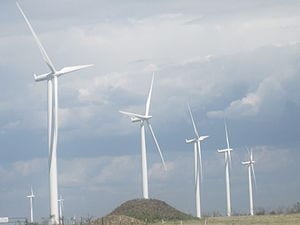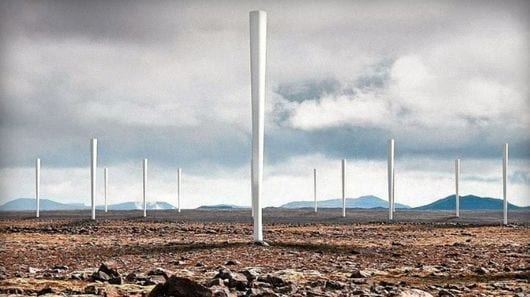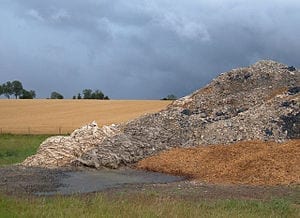
Harvard research suggests real-world generating capacity of wind farms at large scales has been overestimated
“People have often thought there’s no upper bound for wind power—that it’s one of the most scalable power sources,” says Harvard applied physicist David Keith. After all, gusts and breezes don’t seem likely to “run out” on a global scale in the way oil wells might run dry.
Yet the latest research in mesoscale atmospheric modeling, published today in the journal Environmental Research Letters, suggests that the generating capacity of large-scale wind farms has been overestimated.
Each wind turbine creates behind it a “wind shadow” in which the air has been slowed down by drag on the turbine’s blades. The ideal wind farm strikes a balance, packing as many turbines onto the land as possible, while also spacing them enough to reduce the impact of these wind shadows. But as wind farms grow larger, they start to interact, and the regional-scale wind patterns matter more.
Keith’s research has shown that the generating capacity of very large wind power installations (larger than 100 square kilometers) may peak at between 0.5 and 1 watts per square meter. Previous estimates, which ignored the turbines’ slowing effect on the wind, had put that figure at between 2 and 7 watts per square meter.
In short, we may not have access to as much wind power as scientists thought.
An internationally renowned expert on climate science and technology policy, Keith holds appointments as Gordon McKay Professor of Applied Physics at the Harvard School of Engineering and Applied Sciences (SEAS) and as Professor of Public Policy at Harvard Kennedy School. Coauthor Amanda S. Adamswas formerly a postdoctoral fellow with Keith and is now assistant professor of geography and Earth sciences at the University of North Carolina at Charlotte.
“One of the inherent challenges of wind energy is that as soon as you start to develop wind farms and harvest the resource, you change the resource, making it difficult to assess what’s really available,” says Adams.
But having a truly accurate estimate matters, of course, in the pursuit of carbon-neutral energy sources. Solar, wind, and hydro power, for example, could all play roles in fulfilling energy needs that are currently met by coal or oil.
“If wind power’s going to make a contribution to global energy requirements that’s serious, 10 or 20 percent or more, then it really has to contribute on the scale of terawatts in the next half-century or less,” says Keith.
If we were to cover the entire Earth with wind farms, he notes, “the system could potentially generate enormous amounts of power, well in excess of 100 terawatts, but at that point my guess, based on our climate modeling, is that the effect of that on global winds, and therefore on climate, would be severe—perhaps bigger than the impact of doubling CO2.”
“Our findings don’t mean that we shouldn’t pursue wind power—wind is much better for the environment than conventional coal—but these geophysical limits may be meaningful if we really want to scale wind power up to supply a third, let’s say, of our primary energy,” Keith adds.
And the climatic effect of turbine drag is not the only constraint; geography and economics matter too.
The Latest Bing News on:
Wind power
- Advancing Real-Time SDV Solutions: Wind River Announces its Collab with Elektrobiton May 8, 2024 at 10:44 am
The Wind River Studio received major enhancements, including 50% faster Cloud Platform upgrade time (as well as 65% faster Kubernetes upgrade time),plus increased automation and intent-driven ...
- Lab's AI work results in increased revenue, decreased land requirements for wind power industryon May 8, 2024 at 8:04 am
The use of wind as a renewable energy source is expected to become increasingly important in decarbonizing the nation's power sector, but obstacles remain as some communities have restricted where ...
- South Deep wind power decision drawing closer, Q2 update likely on backfill problemon May 8, 2024 at 6:39 am
Mining company Gold Fields expects to be in a position to decide the establishment of a wind power project at the South Deep gold mine, west of Johannesburg, in the third quarter of this year. The ...
- Mozambique: Globeleq to start building wind power plant in Namaachaon May 8, 2024 at 5:10 am
The London-based independent power producer Globeleq (an institution formed by Norwegian and British funds) has announced the construction, in the second half of the current year, of a 120 Megawatt ...
- Wind turbine ‘wake effect’ could reduce arrays’ power output by 30%on May 7, 2024 at 8:57 pm
Downstream turbulence from offshore wind turbines can reduce power generation at nearby turbines, substantially reducing the total potential from planned U.S. offshore wind projects, according to rece ...
- Wind gusts block northern Colorado roadways, knock out power to rural customerson May 7, 2024 at 8:24 pm
Wind gusts from Monday night and Tuesday morning resulted in many rural residents in northern Colorado counties losing power, while others had their driveways and nearby highways blocked by downed ...
- Springs Utilities works to restore power after wind damageon May 7, 2024 at 10:44 am
No classes Tuesday after power pole falls on school “Behind me was a transmission and distribution line that was affected by around these 100 miles-an-hour wind gusts, and our crews have worked to ...
- Colorado Springs wind storm downs power lines, closes schools and leaves thousands without poweron May 6, 2024 at 12:45 pm
Thousands of Colorado Springs residents were without electricity Monday after a windstorm ripped through the Pikes Peak region, according to Colorado Springs Utilities.
- ACWA Power seals $4.85bn Uzbek wind project dealon May 6, 2024 at 5:49 am
The Aral wind project, to be located in the Karakalpakstan region, is poised to become Central Asia's largest wind farm.
- ‘Wake effect’ could drain 38% of offshore wind power, study sayson May 6, 2024 at 3:53 am
The findings from national lab and university researchers upend assumptions about how turbines interact with each other.
The Latest Google Headlines on:
Wind power
[google_news title=”” keyword=”wind power” num_posts=”10″ blurb_length=”0″ show_thumb=”left”] [/vc_column_text]The Latest Bing News on:
Wind power potential
- India’s Adani Green Energy signs PPA with Sri Lanka for two wind projectson May 8, 2024 at 4:09 am
The company will invest $442m to build two wind farms with a 448MW capacity in the country's Northern province.
- Wind turbine ‘wake effect’ could reduce arrays’ power output by 30%on May 7, 2024 at 8:57 pm
Downstream turbulence from offshore wind turbines can reduce power generation at nearby turbines, substantially reducing the total potential from planned U.S. offshore wind projects, according to rece ...
- Thousands without power as severe weather moves through Greater Cincinnation May 7, 2024 at 11:13 am
Thousands of customers are without power as severe ... 3 p.m. There's potential for strong and severe storms starting around 6 p.m. These should end around 11 p.m. or so.All modes of severe weather ...
- New Study Highlights Another Potential Roadblock For Biden’s Offshore Wind Pushon May 6, 2024 at 10:26 am
A new study has identified a potentially massive problem for offshore wind developments that could further hinder the Biden administration’s push for the technology. The study, published in a ...
- Southwest Power Pool issues weather advisory for severe stormson May 6, 2024 at 9:47 am
Southwest Power Pool (SPP) issued a weather advisory for theEastern Reliability Coordination, effective 3 p.m. Monday until 6 a.m. Tuesday.Weather advisories ...
- Petrobras Signs Deal for Potential Offshore Wind Project in Brazilon May 1, 2024 at 11:58 pm
Petróleo Brasileiro SA has signed a memorandum of understanding with the government of Rio Grande do Norte to explore the feasibility of a pilot offshore wind project in the state. Rio Grande do Norte ...
- Wind Energy Newson May 1, 2024 at 5:00 pm
2024 — Wind power is a source of energy that is both affordable and renewable. However, decision-makers have been reluctant to invest in wind energy due to a perception that wind farms require a ...
- The US just proposed 18 GW of new offshore wind saleson May 1, 2024 at 2:04 pm
The US announced two proposals for offshore wind sales that could generate more than 18 GW – enough to power more than 6 million homes.
- Offshore wind, a potential clean energy source for the East Coast, slowly takes shapeon April 30, 2024 at 2:30 am
Offshore wind, which makes electricity without emitting carbon dioxide, is a key plank of President Biden’s plan to lower carbon emissions.
- 3 notable wind turbine innovations to eke out every Watton April 27, 2024 at 9:05 pm
Wind turbines are a towering solution in the global transition toward renewable energy. Today's turbines have undergone significant evolution since the time when windmills generated mechanical power ...
The Latest Google Headlines on:
Wind power potential
[google_news title=”” keyword=”wind power potential” num_posts=”10″ blurb_length=”0″ show_thumb=”left”]










